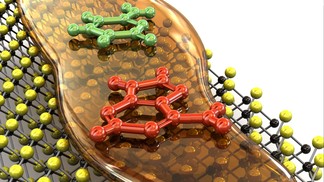Nanopore Sequencing Improved Using Viscous Solution

Swiss researches at Ecole Polytechnique Federale De Lausanne are reporting on success in improving errors rates in nanopore sequencing using high viscosity liquids and slowing down the speed with which nucleotides pass through the pores.
While for the past decade nanopore has been touted as the breakthrough needed to achieve sub $100 genome sequencing, it has hardly made a dent in the next generation sequencing market. Oxford Nanopore’s only attempt at commercial solid state nanopore sequencers is riddled with short sequence reads and high error rates, making it unable to fully replace other commercially available sequencers.
However, the new development at the lab of Aleksandra Radenovic at the Institute of Bioengineering at EPFL could give nanopore sequencers the ability we always wished it had. Turns out that it was the speed with which the nucleotides pass through the pores that affected nucleotide read rates all along. Slowing down the speed give the pore’s additional time to properly identify the nucleotide electrical signals and differentiate them from other nucleotides.
Nanopore’s Immersed in Viscous Liquids
Lead by Jiandong Feng and Ke Liu, the researchers used viscous liquids to slow down DNA translocation through the pores by a magnitude of three orders. This is similar to slowing down a speeding bullet to that of a speeding car. Just imagine asking flash to run through thick honey, thats essentially whats happening here to DNA passing through.
Using a thin film (0.7nm) of molybdenum disulphide (MoS2) with pores of 3nm wide, the team used thick viscous liquid salt solution belonging to the room temperature ionic liquids class. By fine tuning the viscosity of the liquid’s viscosity gradient, the researchers were able to control speeds to readable levels. Using MoS2 fils also makes the entire setup cheaper and less sticky to DNA when compared to graphene.
Competitive Sequencing Speeds
Using this technique, the team was able to make an accurate guess from the average of just four readings of known nucleotides. Slowing down while brings the sequencing speeds down to optimal speeds of 1 to 50 nucleotides/milli seconds, it saves time by bringing down the number of reads required of the same by while keeping the signal to noise ratio higher than 10.
The team is further improving read and error rates, fine tuning viscosity control and aiming to enable the setup to read entire DNA. They are also looking for commercial partners to bring this technology to the market.
Reference: Feng J, Liu K, Bulushev RD, Khlybov S, Dumcenco D, Kis A, Radenovic A. Identification of single nucleotides in MoS2 nanopores.Nature Nanotechnology 21 September 2015. DOI: 10.1038/nnano.2015.219
Source: Arixiv
Image Source: Aleksandra Radenovic lab

